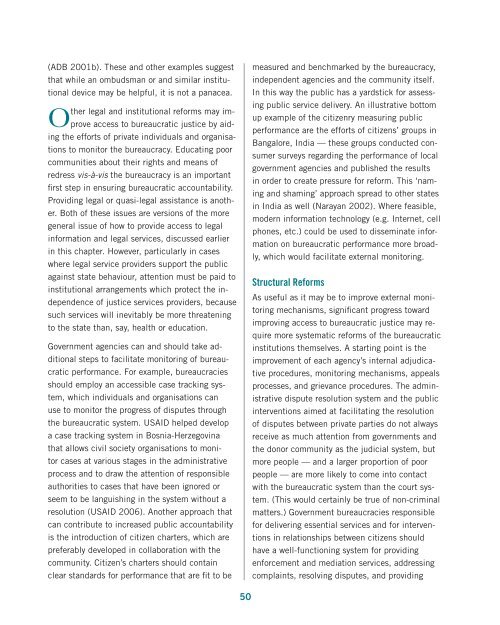Download the file - United Nations Rule of Law
Download the file - United Nations Rule of Law
Download the file - United Nations Rule of Law
You also want an ePaper? Increase the reach of your titles
YUMPU automatically turns print PDFs into web optimized ePapers that Google loves.
(ADB 2001b). These and o<strong>the</strong>r examples suggestthat while an ombudsman or and similar institutionaldevice may be helpful, it is not a panacea.O<strong>the</strong>r legal and institutional reforms may improveaccess to bureaucratic justice by aiding<strong>the</strong> efforts <strong>of</strong> private individuals and organisationsto monitor <strong>the</strong> bureaucracy. Educating poorcommunities about <strong>the</strong>ir rights and means <strong>of</strong>redress vis-à-vis <strong>the</strong> bureaucracy is an importantfirst step in ensuring bureaucratic accountability.Providing legal or quasi-legal assistance is ano<strong>the</strong>r.Both <strong>of</strong> <strong>the</strong>se issues are versions <strong>of</strong> <strong>the</strong> moregeneral issue <strong>of</strong> how to provide access to legalinformation and legal services, discussed earlierin this chapter. However, particularly in caseswhere legal service providers support <strong>the</strong> publicagainst state behaviour, attention must be paid toinstitutional arrangements which protect <strong>the</strong> independence<strong>of</strong> justice services providers, becausesuch services will inevitably be more threateningto <strong>the</strong> state than, say, health or education.Government agencies can and should take additionalsteps to facilitate monitoring <strong>of</strong> bureaucraticperformance. For example, bureaucraciesshould employ an accessible case tracking system,which individuals and organisations canuse to monitor <strong>the</strong> progress <strong>of</strong> disputes through<strong>the</strong> bureaucratic system. USAID helped developa case tracking system in Bosnia-Herzegovinathat allows civil society organisations to monitorcases at various stages in <strong>the</strong> administrativeprocess and to draw <strong>the</strong> attention <strong>of</strong> responsibleauthorities to cases that have been ignored orseem to be languishing in <strong>the</strong> system without aresolution (USAID 2006). Ano<strong>the</strong>r approach thatcan contribute to increased public accountabilityis <strong>the</strong> introduction <strong>of</strong> citizen charters, which arepreferably developed in collaboration with <strong>the</strong>community. Citizen’s charters should containclear standards for performance that are fit to bemeasured and benchmarked by <strong>the</strong> bureaucracy,independent agencies and <strong>the</strong> community itself.In this way <strong>the</strong> public has a yardstick for assessingpublic service delivery. An illustrative bottomup example <strong>of</strong> <strong>the</strong> citizenry measuring publicperformance are <strong>the</strong> efforts <strong>of</strong> citizens’ groups inBangalore, India — <strong>the</strong>se groups conducted consumersurveys regarding <strong>the</strong> performance <strong>of</strong> localgovernment agencies and published <strong>the</strong> resultsin order to create pressure for reform. This ‘namingand shaming’ approach spread to o<strong>the</strong>r statesin India as well (Narayan 2002). Where feasible,modern information technology (e.g. Internet, cellphones, etc.) could be used to disseminate informationon bureaucratic performance more broadly,which would facilitate external monitoring.Structural ReformsAs useful as it may be to improve external monitoringmechanisms, significant progress towardimproving access to bureaucratic justice may requiremore systematic reforms <strong>of</strong> <strong>the</strong> bureaucraticinstitutions <strong>the</strong>mselves. A starting point is <strong>the</strong>improvement <strong>of</strong> each agency’s internal adjudicativeprocedures, monitoring mechanisms, appealsprocesses, and grievance procedures. The administrativedispute resolution system and <strong>the</strong> publicinterventions aimed at facilitating <strong>the</strong> resolution<strong>of</strong> disputes between private parties do not alwaysreceive as much attention from governments and<strong>the</strong> donor community as <strong>the</strong> judicial system, butmore people — and a larger proportion <strong>of</strong> poorpeople — are more likely to come into contactwith <strong>the</strong> bureaucratic system than <strong>the</strong> court system.(This would certainly be true <strong>of</strong> non-criminalmatters.) Government bureaucracies responsiblefor delivering essential services and for interventionsin relationships between citizens shouldhave a well-functioning system for providingenforcement and mediation services, addressingcomplaints, resolving disputes, and providing50
















